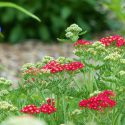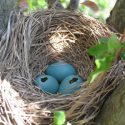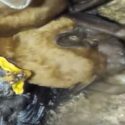 Photo ©
Keith Williams
Photo ©
Keith Williams

Avian Apothecaries
Aromatic herbs such as lavender, sage, and mint are all commonly found in kitchens, gardens, and in soaps and lotions. The plants’ perfumes are intended to attract pollinators and repel herbivores. It is well-documented that aromatic herbs have medicinal properties. However, humans are not the only creatures to utilize medicinal plants; some birds are known to incorporate pungent plants into their nests.
Corsican Blue Tits use up to five different aromatic herbs in their nests. The herbs are strategically placed within the nest, with the average number of herbs increasing as the nesting cycle progresses. Researchers Lambrechts and Dos Santos (2000) experimentally removed herbs from nests. Within days, the birds had replaced them. And for good reason! The study went on to suggest that the “potpourri” of herbs can potentially kill or repel certain parasites and fleas, which in turn results in high body and feather growth rates in developing chicks.
Not only are herbs beneficial for young, according to Gwinner (2012), female European Starlings prefer nests with herbs. Males display plants such as yarrow, hogweed, elder, and cow parsley to females prior to incorporating them into the nest. Starling nests with herbs have high incubation temperatures, providing an energy-savings to the female. Fledglings from nests with herbs also had a greater body mass and were overall healthier with fewer mites.
While we aren’t suggesting that you add fresh herbs to your nest boxes, it is fascinating to know that birds “self-medicate.” Perhaps this spring, consider planting aromatic herbs in your yard, such as yarrow. Sit back and observe your feathered friends. Are they intrigued by your herbaceous offering? If not, you can always use the plants in your kitchen or for aromatherapy!
Thanks to guest student writer, Lillian Ruiz, a sophomore majoring in Environmental and Sustainability Sciences.
References:
Gwinner, H. 2012. Male European starlings use odorous herbs as nest material to attract females and benefit nestlings in Chemical Signals in Vertebrates 12, 353-362, Springer Publishing, New York.
Lambrechts, M. M. and A. D. Santos. 2000. Aromatic herbs in Corsican blue tit nests: The potpourri hypothesis. Acta Oecologica 21(3): 175-178.

Can Feeding Birds Reduce Nest Success?
Many of us enjoy feeding birds, but bird feeders may potentially attract nest predators such as domestic cats, squirrels, jays, and crows. It remains unknown if these predators do extra harm to nesting birds when feeders are around. With about 50 million Americans feeding birds, it is important to understand the consequences of bird feeding on nesting birds, so researchers set out to study just that in two of our favorite species, American Robins and Northern Cardinals.
Researcher Jennifer Malpass and her colleagues at The Ohio State University monitored robin and cardinal nests and surveyed for nest predators in seven residential neighborhoods in Columbus, Ohio. After examining data compiled over four breeding seasons, the researchers concluded the only instance of decreased nesting success was for American Robins in neighborhoods with high concentrations of bird feeders and crows.
The complex relationships among bird feeders, predators, and nest success in human-dominated environments makes it difficult to generalize about whether or not the presence of bird feeders is harmful.
Emma Greig, leader of the Cornell Lab’s Project FeederWatch, points out that this area is ripe for research. “This work is really great. We need to see more research like this in order to get a full picture of the impacts of bird feeding. Even within this study there were both negative and neutral impacts, so imagine the diverse responses we would see if we looked at more species. The time is right for asking these questions.” Read the research summary.

Bats and Birds Bunk Up
Was it for warmth and protection, or a shortage of suitable nest cavities? Noctule bats, common across Europe, were filmed by the Poznań University of Life Sciences (Poland) using the same tree cavity as European Starling chicks. This is the first time bats and birds have been recorded sharing such close quarters. Watch the short clip.
While some people may shudder at the thought of snuggling up with a bat, these furry nocturnal mammals fulfill an important ecological niche by pollinating plants and voraciously eating flying insects. Installing bat boxes on your property is a win-win, as many species of bats are in decline due to habitat loss and an introduced fungal disease.

Youth Citizen Science Ambassadors
The Citizen Science Association, 4-H, and the Cornell Lab of Ornithology are looking for citizen scientists between the ages of 13 and 18 who would like to help spread the word about citizen science.
Ambassadors are expected to dedicate 8 to 10 hours between February and May to help plan and create a social media campaign to connect young citizen scientists across the globe as well as create their own short video for the campaign. Act now! The deadline to apply is February 1. Learn more about how to become involved in this fun project.